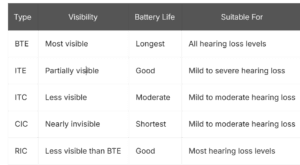
Best Hearing Aids in Delhi – Expert Guidance & Options
When it comes to hearing aids in Delhi, there are several types available to suit different needs and preferences:
- Behind-the-Ear (BTE)
- In-the-Ear (ITE)
- In-the-Canal (ITC)
- Completely-in-Canal (CIC)
- Receiver-in-Canal (RIC)
Each type has its unique advantages and considerations. Here’s a comparison of the most common types:

Leading hearing aid brands in Delhi
Delhi offers a wide range of reputable hearing aid brands, including:
- Phonak
- Oticon
- Starkey
- Widex
- ReSound
- Siemens/Signia
These brands are known for their quality, innovation, and reliability in the hearing aid industry.
Technological advancements in hearing devices
Recent technological advancements have revolutionized hearing aids in Delhi:
- Bluetooth connectivity
- Rechargeable batteries
- Smartphone app integration
- Artificial Intelligence (AI) for sound processing
- Tinnitus management features
These innovations have greatly improved the user experience, making hearing aids more convenient and effective than ever before. As we explore the benefits of using hearing aids in Delhi, you’ll see how these advancements contribute to improved quality of life for those with hearing impairments.
